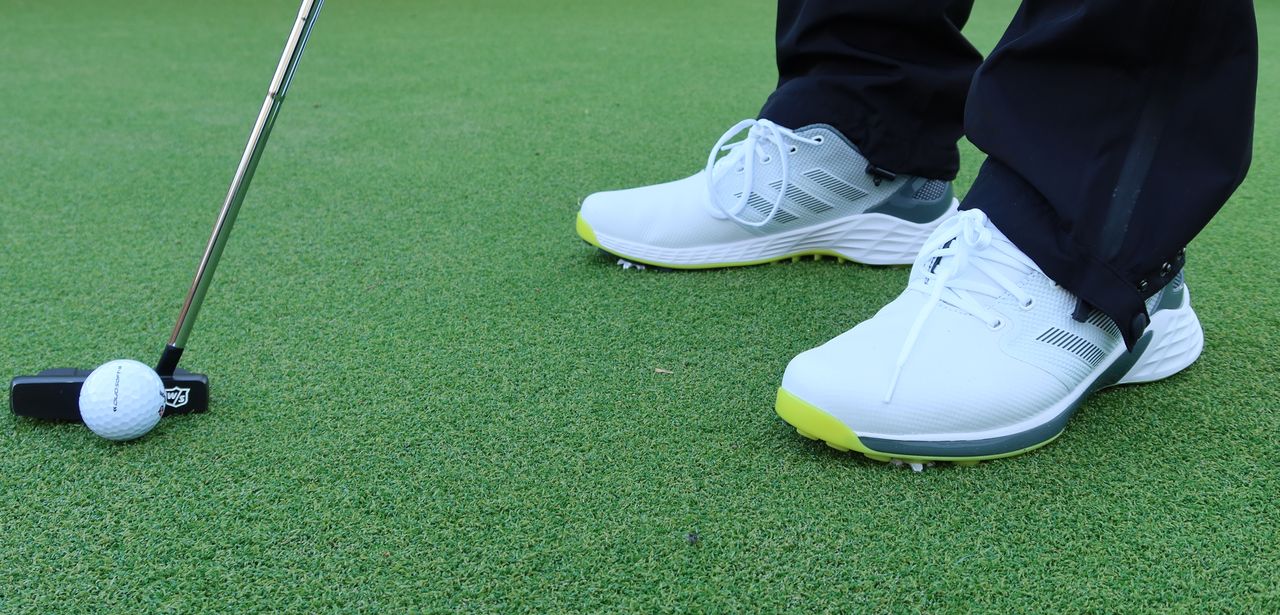

A lot of people with only passing interest in golf probably assume spiked golf shoes remain overwhelmingly the norm. Not so: spikeless golf shoes have come on leaps and bounds and are now the more popular golfing shoe, in some quarters.
In the mid-nineteenth century, Scottish golfers began hammering nails into the soles of their shoes. They did this to help combat the wet conditions on the links courses they played. Occasionally these nails would come loose and skewer their feet but the Scots take their golf seriously and it was deemed a risk worth taking to avoid a costly slip when hitting a tee shot. And so the spiked golf shoe was born.
Although today’s spikes – or ‘cleats’ for our American readers – are unrecognisable from those of the past and they are now soft plastic rather than metal, the basic principle remains the same; golf is easier when you have a solid base to hit from.
Spiked shoes had things very much their own way until the last decade or so when a new, rubber soled, spikeless alternative emerged on the scene to give golfers a choice based on comfort and fashion rather than just plain old boring functionality.
In the early days of this new, training shoe style of footwear, many golfers were unconvinced. Golfing purists were certainly slow to embrace the change as spikeless shoes were seen as little more than glorified trainers, while for professionals and the higher level of club golfer doubts persisted over their suitability to provide the necessary traction a fast swinger of the club requires.
These days such concerns are moot as significant advancements have been made in both styles of golf shoe. Indeed, the rapid improvement in spikeless shoes has forced the spiked shoe to evolve in order to stay ahead of the game, which is great news for golfers as there are now two high quality options when it comes to choosing the best golf shoes.
Spikeless shoes are now able to perform to a higher standard on the course, while in turn spiked shoes are providing the kind of comfort and flexibility that previously you would never have thought possible. Both variations have brought the best out of the other and some manufacturers now make the same shoe design both with and without spikes.
Sign up to the T3 newsletter for smarter living straight to your inbox
Get all the latest news, reviews, deals and buying guides on gorgeous tech, home and active products from the T3 experts
Now on the PGA Tour you’ll see some of the top golfers wearing spikeless golf shoes, although this does depend greatly on the course being played and the climate it is being played in. Tournaments in the likes of Dubai and Saudi Arabia will see a lot of the new style of shoes for example.
But what of the average golfer? Should YOU opt for spiked golf shoes or spikeless golf shoes? Let's look at the pros and cons of both.
Spiked golf shoe or spikeless golf shoe: what type do YOU need?
This isn’t a simple one word answer as much like choosing the right type of golf bag it depends on several factors. All of these factors are essentially based around one thing though; course conditions.
Where do you play? What is the climate? What are the usual conditions of the course? Is it flat or hilly? Dry or wet? What time of day are you usually teeing off? Do you play all year round or are you more of a fair weather golfer?
These are just some of the things you need to take into account when deciding which type of shoe to buy.
If you live in a warm climate and play in dry, humid conditions then a spikeless shoe is going to be just the ticket, especially if you walk the course rather than using a buggy, as comfort is paramount in that situation.
If you play in the UK in autumn or winter when courses can get extremely muddy, however, then spiked shoes will serve you better. Even in summer, courses tend to be damp for early morning tee times when the dew has yet to be burned away.
The type of course matters too. If the course you play has undulating fairways and you often find yourself with sloping lies, you are going to need more traction than a golfer who mostly only plays from flat ground. A damp fairway and a sloping lie is going to need maximum grip to prevent your feet from sliding as you take your shot.
Your golf swing is another factor. If you are a fast swinger of the club or if you have a lot of foot movement in your swing then any time the ground is wet you will want the sturdier base that spikes will give you.
So let’s look at the main requirements you need in a golf shoe and how both varieties of shoe stack up in each category.
Spiked golf shoe or spikeless golf shoe: on-course performance
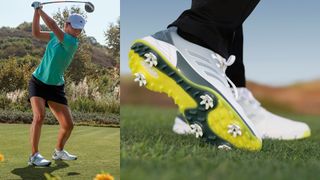
In a golf swing the shoes are your anchor. They are your only connection to the ground, similar to tires on a car. So having traction and grip is vital to maintaining that connection as without a solid relationship to the ground you can't fully commit to your swing.
Being able to swing the club safe in the knowledge that you have a steady base that isn’t going to slip and slide because of conditions underfoot is an important ingredient to good golf. If you’re worried about your footing you will become distracted and lose confidence.
It stands to reason then that on wet turf you will get more grip from having spikes or cleats on your shoes than you will with the rubber nubs you find on the spikeless type.
Spiked shoes are very much all rounders when it comes to golf. You can wear them in any weather, on any course, in any conditions and they will do the same job every time.
The most obvious benefit to these shoes is traction, especially in damp conditions. In the past there was a trade off for that stability as golf shoes were not always built for maximum comfort. That is no longer true.
Spiked shoes have come on in leaps and bounds over the years and the more expensive ones nowadays are as comfortable as anything with ‘spikes’ in the sole can possibly be.
With spikeless shoes, however, you don’t need to be at the top end of the market to find maximum comfort as they’re all lightweight, flexible and comfortable. They aren’t all waterproof though and they aren’t all suitable for difficult conditions, so be sure to check this when buying.
Spiked shoes tend to be better at keeping out the elements but you will find that some of the high end spikeless shoes are now fully waterproof and will keep your feet warm and dry in any conditions just as well as anything with spikes will.
The only real downside to spikeless shoes is how they may perform in wet conditions or in winter mud. On a dry day, or on a course with short grass fairways, spikeless shoes are a dream. Conversely, on a muddy winter tee when you’re sliding all over the place they’re more of a nightmare.
We aren't all fortunate enough to play on perfectly manicured golf courses all year round and in the winter things can get pretty rough at many courses. We’ve all experienced that walk up (or down) a muddy bank to reach the next tee. Even spiked shoes can struggle in those situations but at least they give you a fighting chance of staying upright.
The last thing you need is to be sliding down that bank on the seat of your pants, with your pals in fits of laughter or - even worse - filming it all on their smartphones!
So while spikeless shoes on wet slopes can potentially be a recipe for disaster, they do perform quite well on links courses which tend to be firmer and less muddy than many inland, parkland courses.
Even on links courses though there are times when you may need spikes to prevent slipping, such as at the height of summer when courses can get so dry that the grass is burnt and has that sheen to it. That can be almost as treacherous underfoot as when it’s waterlogged.
That being said, huge advancements have been made in this area and some of the best spikeless shoes will provide almost as much traction as you will get from the soft plastic spikes in a traditional 'golf shoe'.
The difference between spikes and no spikes in wet conditions used to be massive but it is nothing like as pronounced as it was. You won’t get the same level as grip that you get from spikes but in many cases a spikeless shoe will give you all the traction you need.
Another benefit of spikeless shoes is that they do less damage to putting greens. In fact, they do no damage at all. The old metal spikes on golf shoes were notorious for causing ‘spike marks’ which caused putts to jump and bobble offline. The newer, soft plastic spikes you find on modern golf shoes are not really 'spikes' at all and the damage they do to greens is quite minimal, unless you accidentally drag your feet, which can easily happen.
Overall, spiked shoes give you slightly better performance on the golf course mainly because they perform the same regardless of course conditions. This is why most pros still wear spikes much of the time.
Yet performance may not be the decisive factor for the casual golfer. If you walk the course you may put more value on comfort than performance, in which case the occasional slip on a wet fairway may be seen as a small price to pay for not having aching feet at the end of the day.
Spiked golf shoe or spikeless golf shoe: versatility
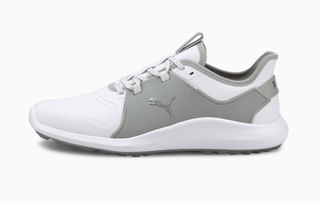
The main benefit of spikeless shoes is that they are basically just trainers, meaning they provide the same comfort level as most trainers. By definition they are more comfortable than spiked shoes because, well, they don’t have spikes.
Even with the most comfortable of spiked shoes it’s impossible to create that same feeling as a luxurious pair of trainers (although some come fairly close) as you can still feel underfoot where the spikes are. This also makes a spiked golf shoe very rigid and inflexible in comparison to a shoe with a flat rubber sole.
Because spikeless shoes often (but not always) look just like trainers you don’t have to change them at any point during your golfing day. The infamous ‘no spikes in the clubhouse’ rule meant that for decades golfers either had to carry a pair of regular shoes in their golf bag to change into, or they were forced to go back to the car to change their footwear if they fancied a swift pint after their round.
Spikeless shoes are as welcome at “the 19th hole” as they are at the previous 18 and that makes life much easier for golfers who like to be sociable and enjoy clubhouse life.
Not only can you wear these shoes on the course, you can wear them anywhere. In this regard they have been transformational. Before the advent of the spikeless shoe, golfers would have to leave the house wearing a pair of flat shoes or trainers because driving a car wearing spikes was not ideal. Even for those who didn’t mind driving in spikes it was still not a good idea in case you needed to stop to get petrol or refreshments on the way to the course.
Spikeless shoes have eradicated that issue completely. You can drive in them no problem and if you need to stop at the supermarket on your way home that isn’t an issue either. You’re basically just wearing trainers so nobody will even notice.
Spikeless shoes are ideal to take on holiday if you are planning on playing a bit of golf before spending the rest of the day sightseeing or at the bar. Unlike when you're wearing spikes there’s no need to change and then have to carry around an extra pair of shoes.
Spiked shoes are great on the course but like a fish out of water anywhere else. A good comparison would be football boots. You wouldn’t drive a car wearing football boots and you wouldn’t go into a shop wearing them as you’d make a terrible racket and you’d be sliding everywhere.
You don’t put football boots on until you’re actually about to play and it was the same for golfers with their footwear, only they had the added problem of whether to then put their change of shoes into their golf bag while they played - adding extra weight and reducing storage space in the bag for anything else they may need - or leave them in the car until the round is over.
While things have improved markedly from the days when a pair of metal spiked shoes would have you sliding around any hard floor, you still don’t really want to be walking around shops in a pair of spiked golf shoes. And, come to that, the owners of the shop don't want you to either.
So for versatility, spikeless comes out well on top.
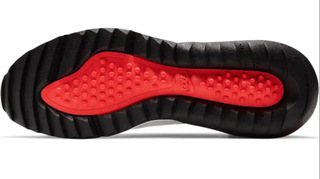
Spiked golf shoe or spikeless golf shoe: looks
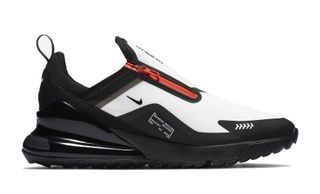
This is very much a subjective thing but the variety of choices available in both types of shoe means there is something to suit everyone. Often you will find the same pair of shoes available in spiked and spikeless, which means you aren’t having to choose between them based on what is more aesthetically pleasing and can instead focus on which style of shoe meets your other requirements.
While there are exceptions, as a good rule of thumb spiked shoes tend to look more traditional and spikeless shoes are very much more modern looking. You can still find traditional looking shoes without spikes, as well as modern, trainer style shoes that do have them. Golfers are very much spoiled for choice when it comes to shoe variety these days.
Generally speaking though, spiked shoes will tend to look more like 'golf shoes' and spikeless will be look more like trainers. If you look at some of the Nike spikeless shoes for example (see above) they just look like premium, fashionable trainers. If you saw someone wearing them on the street you would never in a million years think that they were golf shoes.
That will appeal to some but not to others. Some golfers prefer a traditional look, in which case they should be looking more towards something like some of Footjoy’s classic designs for instance, or the Under Armour Spieth 3 (see below).
When it comes to aesthetics you can find some great looking shoes with and without spikes so neither has the edge in this category.
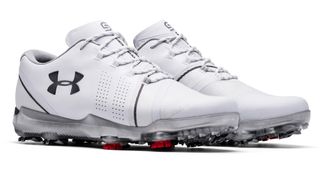
Value for Money
Longevity is a big advantage with a spiked shoe. You are only wearing them on the golf course and most golfers will play only once or twice a week on average, so if you have a good quality pair then they will be able to stand up to whatever conditions are thrown at them and remain as good as new.
They almost all come with replaceable spikes that are readily available in golf shops or online, so this type of shoe should last you a very long time and give you a lot of 'bang for your buck'.
A pair of spikeless shoes can also last you a long time but only if you solely use them for golf. The rubber sole will wear down over time but if you are only playing golf in them they will get you through a lot of rounds before you even need to think about replacing them. It’s only when you’re wearing them all the time that the soles will get worn down much more quickly, but then being able to wear them off the course as well as on it is kind of the point.
If you buy one of the more ‘trainer-like’ style of spikeless shoe then even when the grip has worn down too much for them to be effective on the golf course they’ll still be fine to wear casually. For the most part though, spiked shoes will last considerably longer and therefore offer better value for money.
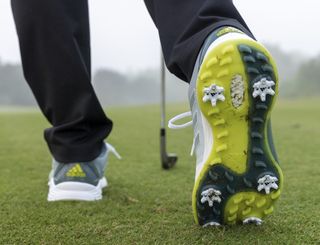
Spiked golf shoe or spikeless golf shoe: which should you buy?
Okay, please don't call this a cop-out.
The fact is, you should really buy both if it is within your budget to do so. You'll have more flexibility and you will definitely use both of them. Having a spiked pair of shoes and a more lightweight, flexible, comfortable pair of spikeless just gives you more options depending on when and where you are playing.
We’ve mentioned all of the practicalities above, but fashion may also factor into your thinking. Which shoes go best with a specific golf outfit? Whether you're matching colours or styles, this is an important consideration for many.
Particularly in the summer, if you’re wearing shorts, you may well prefer the trainer style of footwear as it just goes better. Whereas in the winter when you’ve been forced to put on your best golf waterproofs you may want the more traditional spiked shoe, as light coloured, mesh, rubber soled shoes are going to look a bit wack, especially if they’re caked in mud.
If your budget does not allow for both and it comes down to choosing just the one pair, then spiked shoes will give you that little bit more on-course versatility. When it comes down to it, you can wear spiked shoes on any course in any conditions, but spikeless shoes in bad weather can be a problem, particularly if they aren’t waterproof.
Dave is a distinctly average golfer with (fading) aspirations to be so much more than that. An avid collector of vintage Ping putters and the world's biggest Payne Stewart fan, Dave turned his front garden into a giant putting green to work on the weakest area of his game, but sadly to date he has seen no improvement. In addition to his work reviewing golf gear for T3, Dave is also the founder and editor of Bang Average Golf TV website.
-
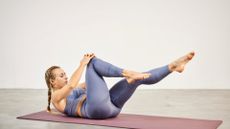 Three underrated Pilates exercises that will build phenomenal core strength
Three underrated Pilates exercises that will build phenomenal core strengthRemove sit-ups and crunches from your routine and add these instead
By Bryony Firth-Bernard Published
-
 I wish this Amy Schumer movie didn't exist – but it's already Netflix's new no.1
I wish this Amy Schumer movie didn't exist – but it's already Netflix's new no.1Kinda Pregnant has been critically lambasted
By Mike Lowe Published